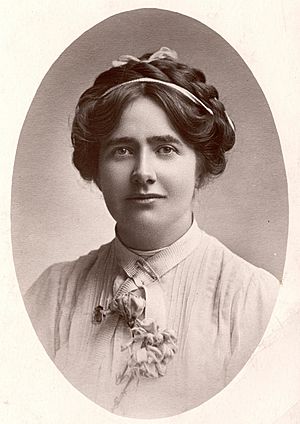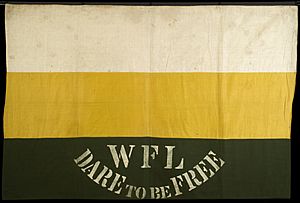Teresa Billington-Greig facts for kids
Teresa Billington-Greig (born October 15, 1876 – died October 21, 1964) was a British woman who fought for women's right to vote. She was a suffragette. In 1907, she helped create the Women's Freedom League. She had left another group, the Women's Social and Political Union (WSPU), because she felt its leaders were too controlling.
In 1904, the WSPU hired her as a speaker. She traveled around, sharing her ideas. On April 25, 1906, she famously showed a 'Votes for Women' banner in the House of Commons. This was during a debate in the British Parliament. In June 1906, she was arrested during a protest outside the home of Chancellor of the Exchequer H. H. Asquith. She became the first suffragette to be held in Holloway Prison.
Teresa also founded the Women's Billiards Association in 1931. She wrote books like The Militant Suffrage Movement (1911). This book shared her thoughts on the suffragettes' methods. Another book, The Consumer in Revolt (1912), looked at how buying things was connected to women's rights. Her old papers and writings are kept at the Women's Library in London.
Contents
Early Life and Education
Teresa Mary Billington was born in Preston, Lancashire, England, on October 15, 1876. Her mother, Helen Wilson, ran a small shop. When Teresa was 13, she left school and started learning the hat-making trade.
However, Teresa wanted to study more. At 17, she left home. She went to live with her uncle's family in Manchester. There, she took night classes and trained to become a teacher.
She taught at a Roman Catholic school in Manchester. In her free time, she studied at the University of Manchester. Teresa's parents were Roman Catholic, but she became an agnostic as a teenager. This meant she wasn't sure if God existed. She later joined the Municipal Education School service. She had strong feelings about not teaching the Bible in schools.
In 1903, she met Emmeline Pankhurst, a famous leader for women's rights. Pankhurst convinced Teresa not to protest her school's rules. Instead, she helped Teresa get a job at a Jewish school. That same year, Teresa joined the Independent Labour Party. She became an organizer for them. In April 1904, she started the Manchester branch of the Equal Pay League. This group worked for equal pay for teachers.
Fighting for Women's Vote
In 1904, the Women's Social and Political Union (WSPU) hired Teresa as a traveling speaker. She went to London with Annie Kenney. Teresa's strong arguments inspired Annie. Together, they worked to get more people to support women's right to vote. In 1905, Keir Hardie asked her to be a full-time organizer for the WSPU. She worked with the Labour Party.
Teresa helped organize protests and get the word out. On April 25, 1906, she showed a 'Votes for Women' banner. She did this from the Ladies Gallery in the House of Commons. People shouted and booed, but she made her point.
In June 1906, Teresa was arrested during a protest. This happened outside the home of Chancellor of the Exchequer H. H. Asquith. She was accused of hurting a police officer. Teresa said the officer grabbed her roughly, causing bruises. She refused to accept the authority of the magistrates' court. She argued that women had no say in making the laws. She was told to pay a fine or go to prison for two months. She refused to pay. She became the first suffragette sent to Holloway Prison. However, she was released after a few days. Someone paid her fine without her knowing.
Later in June 1906, Teresa helped the WSPU campaign against the Liberal Party in a special election. She worked with Emmeline Pankhurst and Annie Kenney. She then went to Scotland to organize WSPU activities there. Her speeches impressed and influenced Janie Allan.
However, by 1907, Teresa was unhappy. She felt her ideas for the WSPU were ignored. Disagreements with the Pankhurst family led her to leave the group.
Starting the Women's Freedom League
In September 1907, Emmeline Pankhurst changed the WSPU's rules. She and her daughter Christabel Pankhurst took full control. On September 14, Teresa Billington-Greig and others wrote an open letter. They explained their concerns about how the WSPU was run.
These unhappy members left the WSPU. They formed a new group called the Women's Freedom League (WFL). Their motto was "Dare to be Free." Their colors were white, gold, and green. Teresa Billington-Greig became the main organizing secretary for the WFL.
Teresa left the WFL in December 1910. She felt the group was too focused on aggressive tactics. She believed the Pankhursts cared more about getting the vote than about wider freedoms for women. Teresa wanted full equality for men and women. She thought that using bad tactics would not lead to good results.
Later Life and Work
After leaving the WFL, Teresa worked as a writer and speaker for three years. She was not involved in activist groups during this time.
During World War I, Teresa helped raise money for ambulances. For example, she supported Elsie Cameron Corbett in 1914. This helped raise money for the "Scottish Lassie" Motor Organisation Fund. This fund supported hospitals for women serving abroad. She also organized events for the British Sportsmen's Ambulance Fund in 1916. She also filled in for her husband at the billiard company where he worked.
In 1931, she led the first meeting of the Women's Billiards Association. She became the first vice-chairman and acting secretary of the group.
In 1936, she worked briefly for the Business and Professional Women's Club. In 1937, she rejoined the Woman's Freedom League. After World War II, this group became known as Women for Westminster.
She was also a member of the Six Point Group. This group was started in 1921 by Lady Rhondda. It worked to change laws in six important areas for women.
Teresa wrote about the history of the suffragette movement. She also wrote articles that criticized their methods. In 1911, she wrote "Feminism and Politics." She said there was no clear plan for women's rights. Her book The Militant Suffrage Movement came out in 1911. Historian Brian Harrison called it a very insightful book. She also wrote that the militant movement was too narrow. She suggested new tactics like strikes and boycotts. Her book The Consumer in Revolt (1912) explored how buying habits related to feminism. Her work was read and discussed widely in the United States.
Her old papers are kept at the Women's Library in London. Her daughter, Fiona Billington-Greig, donated more documents in 1997.
Personal Life
In 1906, while in Scotland, Teresa met Frederick Lewis Greig (1875/76–1961). They got married in Glasgow on February 8, 1907. They decided to use the last name Billington-Greig. They also agreed to be equals in their marriage.
Their daughter, Fiona, was born in December 1915.
Teresa Billington-Greig died from cancer on October 21, 1964, in London.
Her Legacy
Some historians have said that Teresa Billington-Greig did not achieve as much as she could have. They suggest her difficulty in compromising might have limited her impact. However, D. Thom wrote that she always kept her feminist beliefs. She believed that women working together, especially as consumers, could bring about change. She also believed in the power of women's independent groups to create cultural change.
Despite her own feelings of frustration, her work has inspired many. June Hannam and Myriam Boussahba-Bravard called her achievements "impressive." They noted her work to get women chosen as political candidates. She was also involved in groups for women electricians and the Women's Billiards Association. She was the main earner for her family in the 1930s.
Teresa herself was disappointed with her accomplishments. But a book about her writings, The Non-Violent Militant: Selected Writings of Teresa Billington-Greig (1987), hoped to show that she was not a failure. Her name and picture are on the plinth of the statue of Millicent Fawcett in Parliament Square, London. This statue was unveiled in 2018. It honors 58 other women who supported women's right to vote.
See also
 In Spanish: Teresa Billington-Greig para niños
In Spanish: Teresa Billington-Greig para niños



